নটর ডেম কলেজ, ঢাকা | |
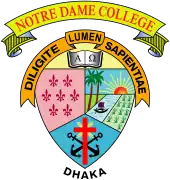 Seal of Notre Dame College | |
Other name | NDC |
|---|---|
Former name | St. Gregory's College |
| Motto | Latin: Diligite Lumen Sapientiae |
Motto in English | Love the light of wisdom |
| Type | |
| Established | November 3, 1949 |
| Accreditation | Dhaka Education Board |
| Affiliation | National University, Bangladesh |
Religious affiliation | Catholic Church (Congregation of Holy Cross) |
| Endowment | Christians, Ethnic minorities |
| Principal | Fr. Hemonto Pius Rozario CSC (2012 - present)[1] |
| Vice-principal | Fr. Leonard Sankar Rozario CSC[2] |
| Students | 7000 (As of 2019) |
| Address | Arambagh, Motijheel , , 23°43′52″N 90°25′15″E / 23.7310°N 90.4209°E |
| Campus | Urban |
| Language | Bangla and English |
| Demonym | Notredamians |
| Alumni name | Notre Dame Alumni Association |
| Colors | Cream (Shirt) Black (Pant) |
| Website | ndc.edu.bd |
 | |
Notre Dame College, Dhaka (Bengali: নটর ডেম কলেজ, ঢাকা), also known as NDC, is a Catholic higher secondary school (in the Indian subcontinent, as in the United Kingdom, higher secondary schools comprising the 11th and 12th years of education are often referred to as colleges) as well as a degree college affiliated to the National University.
It is one of the oldest educational institutions in Dhaka, Bangladesh, established in 1949. This institution is administered by the Congregation of Holy Cross, Society of Priests. The college also offers three years of degree program, Bachelor of Arts (BA Pass Course) and Bachelor of Social Sciences (BSS Pass Course). In 2019, the institution celebrated its 70th anniversary.[3]
History
Early history
In 1947, after the Partition of India, the newly independent government of Pakistan requested the head of the Catholic Church in Pakistan to establish a few colleges. In response to the government's invitation, the then Archbishop Lawrence Leo Graner instructed the priests and nuns of the Holy Cross Congregation to establish colleges for boys and girls separately. On November 3, 1949, the Holy Cross Fathers established St. Gregory's College in Dhaka's 82, Municipal Office Street, Laxmi Bazar, as an extension of St. Gregory's High School. The college started with 19 students in the arts and commerce streams. Later, in December 1950, the institution was moved to 61/1 Subash Bose Avenue, Laxmi Bazar. In the same year, the college was affiliated with the University of Dhaka. Among the students who joined the institution in 1951 were Kamal Hossain, the former Foreign Minister of Bangladesh. In 1953, he topped the Higher Secondary Examination in East Pakistan.
In 1950, 8 students appeared for the University of Dhaka examinations, of whom 5 passed with first division. In 1951, the institution's student population was 55. In that year, the students of the college staged William Shakespeare's The Tempest for three nights in the courtyard of St. Gregory's High School. Among the students of 1952 were Sirajul Islam Chowdhury.
In 1953, Richard William Tim established the first debating club of East Pakistan, the Notre Dame Debating Club. In the 1952-53 academic year, Notre Dame College received the approval of the University of Dhaka to offer BA classes. In the 1953-54 academic year, Principal Richard William Tim introduced the first science stream at the college. Practical classes were held in a tin shed next to the main building. On September 18, 1954, Richard William Tim founded the Notre Dame Science Club, the first informal science research center in the subcontinent.
At the same time, the college's first weekly "Chit-Chat" and annual "Blue and Gold" were published. At the same time, the Notre Dame Photography Club and the Literary Guild were formed.
In 1954, the college was moved from Laxmi Bazar to Arambagh. At that time, it was renamed Notre Dame College. The college initially offered courses in arts and commerce, but later in 1955, it offered BA courses. In 1959, it was recognized as the best college in East Pakistan in various university examinations. In 1960, the college also offered BSc courses. That year, due to a shortage of teachers at the college, several volunteer teachers from a British organization called the British Volunteer Service (British Volunteers Service Overseas) joined as teachers. They taught at Notre Dame College from 1963 to 1970. After the construction of the new building was completed in 1960, Principal James L. Martin died of typhoid on March 21 of that year. The new building was named after him as "Father Martin Hall". Then, Theophilus Amal Ganguly became the first Bengali principal, replacing James Martin. He retired from the college after serving as principal for only seven months. He was later appointed the first Bengali bishop and archbishop of Dhaka.
Liberation War and its aftermath
The academic activities of Notre Dame College were disrupted due to various political instability, including the 1968-69 mass uprising. In 1971, during the Liberation War, Richard William Tim was the principal of Notre Dame College. The government instructed Notre Dame College, like other educational institutions, to keep its regular activities running during the war. However, the institution was closed due to the absence of students. At that time, the BSc course started in 1960 was closed. During the war, the last few weeks the institution's premises was used as a safe place for the Red Cross-United Nations, and 44 UN officials chose the institution as their safe haven.
On December 14, 1971, two young doctors from Dhaka Medical College Hospital, Azharul Haque and Humayun Kabir, were abducted from their homes and tortured to death by members of the Al-Badr forces and their bodies were left near Notre Dame College.
From 1954 to 1971, the I.Com was closed at the college, but it was later reopened. From the 1972-73 academic year, the B.Com course was started instead of the BSc course.
After the liberation war
After the liberation war, Richard William Tim left teaching and became involved in the reconstruction of the country. He worked in the fields of relief, rehabilitation, and human rights through private development organizations. Notre Dame College students also went to remote areas to help with relief and rehabilitation work with the help of teachers on behalf of the institution.
In 1973, Bangladesh was hit by a devastating flood. The college was closed and the institution's manpower was deployed to relief work. The then principal Richard Tim formed the relief and rehabilitation organization "Core". Food was provided for about 1,500 people per day on the campus of the institution. The administration also helped the government to cope with the disaster in the 1974 flood and famine. In recognition of his service, Principal Richard William Tim was awarded the Ramon Magsaysay Award in 1987.
In 1974, the Government of Bangladesh made Bengali the medium of instruction in schools and colleges. Notre Dame also started teaching in Bengali. This made it easier for many people to learn. At the same time, James T. Benas, a teacher of the English department of the college, started an English language course for the practice of English as a second language. Anyone who passed the SSC examination could participate in the course. The course was initially launched for teachers, but later it was opened to students. This course, which started in 1974, is still in operation. Currently, the course is being run by the English department teachers of the college. In 1992, the college became affiliated with the National University. In 1997, English was again introduced as the medium of instruction in the college.
Description
Naming and Motto
The name Notre Dame is derived from the French word "Notre Dame" (French: Notre Dame), which means "Our Lady". In Roman Catholicism, Notre Dame refers to Jesus' mother, Mary. This college, which is run by Catholics, is named after Mary.
The college's motto is written in Latin. The motto is used unchanged on the college's emblem. The motto is: Diligite Lumen Sapientiae, which translates to "Love the light of wisdom". In Catholic doctrine, Jesus' mother Mary is a symbol of wisdom. The word "wisdom" (Latin: Sapientia, wisdom from Sapientiae, of wisdom) refers to the college's main purpose, which is to acquire knowledge and to attain the Creator, the source of knowledge. The word "light" (Latin: Lumen) refers to the ability to dispel darkness and to distinguish between truth and falsehood. And the word "love" (Latin: Diligite) refers to the acquisition of knowledge with love.
Emblem and Philosophy
The most prominent feature of the Notre Dame College emblem is an open book, with the capital Greek letter Alpha (Α) on the left page and the capital Greek letter Omega (Ω) on the right page. Alpha and Omega are the first and last letters, respectively, of the Greek alphabet. This refers to both universal knowledge and a quote from Jesus in the Book of Revelation in the Bible. Additionally, the book is a symbol of knowledge. Taken together, these symbols express the following: all knowledge acquired over the ages is stored in the book, and only by acquiring it can life become illuminated.
The lower part of the emblem has three fields. In the left field, there are seven lotus flowers. The lotus is a symbol of purity. The seven lotus flowers in the emblem represent the seven sorrows of Mary's life. She is called the "Mother of Sorrows" in remembrance of the seven sorrowful events in her life. This refers to the arduous acquisition of knowledge. The scene in the right field, with a river, a moving boat, golden rice fields, and an endless blue sky, symbolizes the college's location in the green and lush Bangladesh. The lower field depicts a cross emitting rays of light, which sits on the chests of two anchors placed crosswise. This refers to the symbol of the Congregation of Holy Cross, the order of monks that founded the college. This symbol represents the following: just as Jesus' death on the cross brought salvation to mankind, so too can salvation be found by clinging to Jesus crucified, like an anchor. The light that spreads from the cross symbolizes the light of knowledge and the magnanimity of Jesus Christ.
The college authorities have officially determined a philosophy and course of action. The motto of the philosophy is "Notre Dame College students: dedicated, creative, skilled, and responsible." The institutional philosophy is as follows:
"The goal of education at Notre Dame College is to develop the whole person - to develop students to be dedicated, creative, service-oriented, proficient and efficient in acquiring and applying knowledge, and responsible in facing the challenges of the times."
Gallery
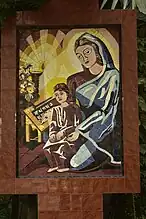
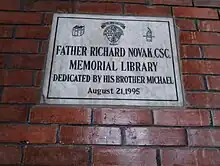
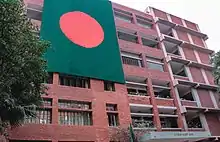
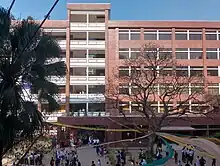
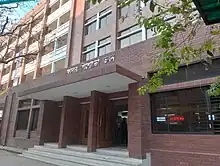
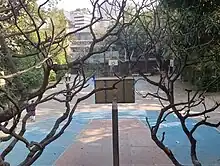


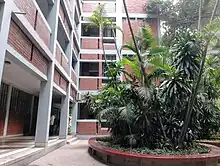
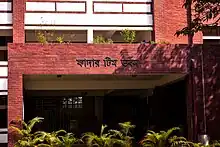
Robert Boughey An American architect born in Pennsylvania, USA. He completed his Bachelor of Architecture from Pratt Institute, Brooklyn, New York in 1959 and received Diploma in Tropical Studies from AA School of Architecture, London in 1967. He is a former research professor of architecture at Pratt institute. He is the architect of the main structure of Notre Dame College.
Students
Students of Notre Dame College are known as "Notredamians". Every year Notre Dame College admits around 2000-2100 students in science, around 410 students in humanities and around 750 students in business studies group through one of the most competitive college admission process in the country. Currently, it consists of 17 sections for students in science terming each as "Groups". In case of science, groups 1 to 14 include Bangla medium students and the rest 15, 16 and 17 groups admit English version students. Humanities has groups H, W and G while the business studies has groups A, B, C, D, E and F. [4]
Extracurricular clubs
The college has 26 extracurricular clubs.[5]
Notre Dame Nature Study Club
Notre Dame Nature Study Club also known as NDNSC, is the first nature club in the country.[6] It was established on 29 August 1984 by Mizanur Rahman Bhuiyan, former lecturer of Notre Dame College and also the founder and chairman of Nature Study Society of Bangladesh.
Every year it organizes the most prestigious nature summit of the country. Its motto is 'Love the beauty of nature'. Every year it publishes its annual magazine "Nisarga".
Notre Dame Science Club
Notre Dame Science Club also known as NDSC, is the oldest science club in the country.[6] It was established on 18 September 1955 by the ex-principal of the college Father Richard William Timm, CSC. It celebrated its Golden Jubilee in 2005.[7] And celebrated its 60 years in 2015. Every year it organizes the biggest science fair at college level in the country.
Its motto is 'Science In Human Welfare'. College's 3 quiz team "NDC Gold", "NDC Blue" and "NDC Green" are maintained by Notre Dame Science Club. Every year it publishes its annual magazine "Audri" and wall magazine "Abiskar(আবিষ্কার)", "Focus(ফোকাস)" & "Trimatrik(ত্রিমাত্রিক)". Moreover, Notre Dame Science Club also organizes different workshops and seminars which help its members to gather knowledge and improve their skills.
Notre Dame Rotaract Club
Notre Dame Rotaract Club (NDRC)[8] is the first Rotaract club in the college level of Bangladesh. The club was founded in 1991 due to much eagerness and endeavor of Subrata Debnath, a student of academic year 1989-90 of Notre Dame College, Dhaka. Its objective is to form leadership quality, to build up notable personality, to make scopes of learning about the social, national and international situation, to give the chance of working together to enhance the spirit of cooperation.
Notre Dame Photography Club
Photography is an art, an art of trying your best to capture a frame that has been living inside your imaginations for an uncountable amount of time. With a view to helping the students flourish in this art form, Notre Dame Photography Club was established on 9 August 2017. Md. Moin Uddin Ahasan Habib, lecturer of Zoology of Biology Dept. is serving as the hon. moderator of this club.
Its motto is "Frame your dreams." Every year it hosts its annual photography event "Aperture" and has an annual magazine named "JPEG".
Notre Dame International Understanding and Relation Club
Notre Dame International Understanding and Relation Club (IURC) is one of the oldest International Relation Club of the country and the first International Relations Club in high school/college level. It was established on 20 February 1993. The club is renowned for hosting various international programs like Education Fair, BANMUN etc.
It also works along with International communities like American Center Dhaka, British Council etc. This club arranged the first ever Mock Model UN in Notre Dame College and also arranged the first Model UN of Notre Dame College titled Notre Dame College Model United Nations[9] in 2017. The Second Session of NDCMUN took place from 11 to 13 January 2018 with more than 500 participants, making it one of the largest Model UNs in the country.[10]
Notre Dame Math Club
Notre Dame Math Club was established on March 14, 2017 (Pi Day). The Club regularly organizes seminars, workshops, and tutorial classes for students interested in mathematics. It also helps weak students develop skills in mathematics.
Apart from regular programs, the club also organises the annual inter-school/inter-college program called the Notre Dame Math Festival.[11] During this festival various mathematical competitions are held among school and college-level students from multiple institutions. The club annually publishes a handwritten scrap magazine called The Number on Pi Day. On Pi Day 2018, the club published its first printed annual magazine called The Function.
Notre Dame Writer's Club
This club was founded on July 29, 2001. Motto of this club is 'অক্ষরে আঁকি সৃষ্টির সৌন্দর্য’ or 'Depicting the beauty of creation in letters'. Dr. Mizanur Rahman is the current moderator of this club. This club arranges workshops on creative writing, book publishing and journalism. Story writing, handwriting and quiz competitions are arranged regularly as well. Members of this club usually edit 'Dhak-Dhol Chit-Chat', the quarterly publication of Notre Dame College, Dhaka.
Juba Red Crescent Club, Notre Dame College
International Red Cross Red Crescent society is working in the world everywhere through volunteering since its opening. We Juba Red Crescent Club, Notre Dame college.
Notre Dame Abritti Dal
The first college-level recitation organisation in the subcontinent, Notre Dame Abritti Dal, was founded on August 18, 1992, under the leadership of Mrs Marlin Clara Penheiro, Head of the Bengali Department and assistant professor of Notre Dame College. The club, with the motto “বাক্শিল্পকে সমৃদ্ধ কর” meaning “Enrich the art of speech,” has been representing Notre Dame College and promoting art and culture for more than 30 years.
The Notre Dame Abritti Dal has affirmed itself as a prominent entity in the realm of speech and recitation by organising 22 national speech art festivals. The club also has an annual publication titled ‘বৃন্দ’ and a wall magazine named ‘নৈবেদ্য’, which both serve as avenues for the club to showcase the literary talents and contributions of its members.
The club currently boasts a membership of over 200 individuals, with Shahrim Al Farabi serving as the President and Mainul Islam Tanim as the General Secretary of the current executive committee, which comprises 11 members. Notre Dame Abritti Dal's dedication to enriching the art of speech has made it a reputable and esteemed organisation among experts in the field.
Notre Dame Yoga and Meditation Club
Merging finitude into infinity with Mr. Swapan Halder, lecturer of English, serving as the Hon. Moderator of Notre Dame Yoga and Meditation Club.
Notre Dame Media and Communication Club
Founded on 2022, Mrs. Shapla Banik is serving as the Hon. Moderator of the club.
Publications[12]
Blue and Gold is the yearbook of Notre Dame College. Notre Dame College publishes students' quarterly magazine Dhak Dhol - Chit Chat. Each club has its own yearly magazine/publication. Among them AUDRI of Notre Dame Science Club is the most famous. Nishorga, annual magazine of Notre Dame Nature Study Club is also worth mentioning.
Notre Dame International Understanding and Relation Club (NDIURC) also publishes its own annual magazine titled 'Jogajog' with couple thousand circulations. From last few years Notre Dame Natya Dal has been publishing Mancha, a magazine depicts its activities and about theater.
Notre Dame Math Club publishes a hand-designed scrap magazine called The Number, and the annual magazine called The Function on Pi Day. Notre Dame Information and Technology Club publishes their own magazine called Recursion which is given to the winners of various events of NIDTC's Annual Fest and its club members and well wishers.[13]
Organization and administration
The college is managed by Christian priests of the Congregation of Holy Cross in Dhaka. Since its establishment, ten priests have served as the principal of the college.
- John J. Harrington (1949 - 1954)
- James L. Martin (1954 - 1960)
- Theotonius Amal Ganguly (March 1960 - October 1960)
- William Graham (1960 - 1967)
- John Vanden Bossche (1967 - 1969)
- Joseph S. Peixotto (1969 - 1970)
- Richard Timm (1970 - 1971)[14]
- Ambrose Wheeler (1971 - 1976)
- Joseph S. Peixotto (1976 - 1998)
- Benjamin Costa (1998 - 2012)
- Fr. Hemanto Pius Rozario[1] (2012–present)
Among them, Father Timm was a renowned biologist and a winner of the 1987 Ramon Magsaysay award for International understanding. Father Timm was also the founder-moderator of Notre Dame Science Club and Notre Dame Debating Club.[14]
Notable alumni
See also
References
- 1 2 নটর ডেম কলেজের নতুন অধ্যক্ষ নিয়োগ [New Principal Appointed in Notre Dame College]. Daily Sangram (in Bengali). 13 December 2012. Retrieved 14 August 2020.
- ↑ নবীনবরণ ও ছাত্র-অভিভাবক নির্দেশিকা (in Bengali). Notre Dame College. 2014. p. 20.
- ↑ "Notre Dame College in Dhaka Celebrates its 70th Anniversary". Congregation of the Holy Cross. 20 February 2019. Retrieved 9 January 2021.
- ↑ "Notre Dame College Admission". The Daily Ittefaq. Dhaka, Bangladesh. 10 June 2015. Retrieved 9 July 2015.
- ↑ "Our Clubs". Notre Dame College, Dhaka. Retrieved 28 September 2021.
- 1 2 "About Us". Notre Dame Science Club. Archived from the original on 18 January 2017.
- ↑ "Notre Dame Science Club golden jubilee!". Rising Stars!. The Daily Star.
- ↑ "Welcome to Notre Dame Rotaract Club (NDRC)". Notre Dame Rotaract Club.
- ↑ "NDIURC". NDIURC. Retrieved 13 June 2017.
- ↑ "Notre Dame College Model United Nations". Notre Dame College Model United Nations.
- ↑ "2nd Notre Dame Math Festival Oct 12-13". The Daily Star. 8 October 2018. Retrieved 27 November 2018.
- ↑ admin. "Publications – Notre Dame College, Dhaka". Retrieved 28 September 2021.
- ↑ "NDITC_init | NDITC".
- 1 2 "Timm, Richard William:CITATION". Archived from the original on 24 September 2015. Retrieved 9 July 2015.
Further reading
- Benjamin Costa (2012). "Notre Dame College, Dhaka". In Sirajul Islam; Miah, Sajahan; Khanam, Mahfuza; Ahmed, Sabbir (eds.). Banglapedia: the National Encyclopedia of Bangladesh (Online ed.). Dhaka, Bangladesh: Banglapedia Trust, Asiatic Society of Bangladesh. ISBN 984-32-0576-6. OCLC 52727562. OL 30677644M. Retrieved 1 December 2023.
- Ahmed, S M Tanveer; Burrell, David B CSC (2018). Christian Missions in East Bengal : the Life and Times of Archbishop Theotonius Amal Ganguly, CSC (1920-1977). La Vergne: Wipf and Stock Publishers. ISBN 978-1-4982-4018-5. OCLC 1088333298.
- Gillespie, Charles P.; Peixotto, Joseph S. (2001). The Spirit of Notre Dame: A History of Notre Dame College : Dhaka, Bangladesh, 1949-2000. Dhaka: Provincial House. OCLC 51547028.
- Timm, Richard W. (1995). Forty Years in Bangladesh: Memoirs of Father Timm. Caritas Bangladesh. ASIN B0006F9QUO.